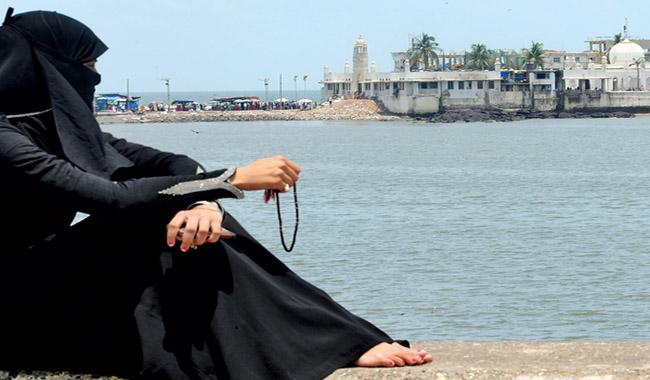Mumbai: After five years and a series of legal battles and agitations, around 250 women entered the famous Haji Ali dargah here on Tuesday afternoon and solemnly offered prayers, an activist said.
The group comprised women from all over India, including office-bearers of NGO Bharatiya Muslim Mahila Andolan (BMMA) and their supporters.
They arrived at the shrine located on the rocks in the Arabian Sea off Worli, were warmly welcomed by a couple of trustees of Haji Ali Dargah Trust and officials and guided them to mazaar (grave) of revered Muslim saint, Sayyed Peer Haji Ali Shah Bukhari.
“They came in a very dignified manner, adhering to the rules of the Trust, silently offered prayers, flowers and ‘chadars’ at the shrine,” trustee Suhail Khandwani told IANS.
Many women who made their maiden visit went around the tiny rocky islet, the small mosque and clicked selfies galore.
BMMA co-founder Noorjehan S. Niaz said all the women activists came away pleased with the unique experience at the dargah on Tuesday.
“The trustees and officials were extremely courteous and helpful. Very thoughtfully, they offered us tea and refreshments and showed us around the place,” Niaz said after returning from the dargah.
“In fact, women’s entry had been allowed from November 7 onwards, but from today it has become official. It will be routine now,” she said.
Till June 2012, women were allowed entry upto the mazaar but suddenly it was stopped.
In 2014, the BMMA and others challenged the move of the Haji Ali Dargah Trust in the Bombay High Court.
On August 26, Justice V.M. Kanade and Justice Revathi Mohite-Dhere had ruled in favour of the petitioners and directed the trust to allow equal access to women, which the trust challenged in the Supreme Court.
The Supreme Court on October 24 delivered its verdict on grounds of equal access to men and women, even as the trust expressed readiness to allow women into the mazaar.
“It was a fight for equality, ending gender bias and our Constitutional rights. We are happy that it has resulted in women and men getting equal unrestricted access right till the sanctum sanctorum,” said Niaz.
Khandwani said that as before (2012) there would be separate entry for men and women, but henceforth nobody would be allowed to touch the peer’s tomb.
Under the new arrangements, all devotees would wait and pray nearly two metres away from the tomb with rights of equal access to all.
The Dargah was constructed in 1431 in memory of Bukhari, a wealthy Muslim merchant from Bukhara (in Uzbekistan now).
At one time, he renounced all his worldly possessions, travelled all around the world, made a pilgrimage to Makkah and finally settled in what would become Bombay.
According to local legends, once he saw a poor woman crying over oil spilt from her vessel, afraid that her husband would thrash her.
He took the woman to the spot where the oil had spilt and jabbed his finger in the earth and oil gushed out. The happy woman filled up her vessel and went home.
Later, the saint had tormenting dreams of how he had injured the earth by his action. He fell ill and instructed his followers to throw his coffin into the Arabian Sea in the event of his death.
He died during his pilgrimage to Makkah and the casket carrying his body miraculously was swept back to the shore of Worli and got stuck in the rocks there.
His Dargah was constructed at the same spot and on Thursdays-Fridays, it is visited by large number of pilgrims of all religions from India and abroad to seek his blessings.
–IANS

